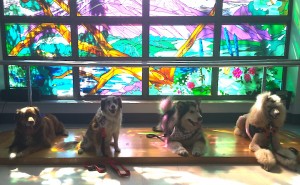Semi-private lessons are my new favorite type of service. They cover a number of client “problem” areas that we don’t always get the opportunity to address through private instruction or group classes.
What Is A Semi-Private Lesson
Technically, the definition should be fairly obvious. A semi-private would assume that it’s more than one client and less than a regular group class. How you market it determines how it’s viewed.
The Smaller Class
Reactive Rover classes are typically smaller in size, but aren’t really sold as semi-private instruction. This is probably due to the classes taking place in a facility that does other group classes. Marketing a group class as “smaller,” or semi-private allows you to charge more per person per class to make up the income difference you’d normally have in a regular sized class. The smaller class should be no more than 3 or 4 students to make it exclusive. There is a balance with these classes. They have the opportunity to fill up quicker, but you need people with the income to pay more. Sales points can be “more one on one instruction,” or “great for shy or timid dogs.”
Try a few different naming conventions to see which one resonates with your target demographic.
The Group Private Lesson
Private instruction is usually geared for people who can’t make a group class or may have a dog that doesn’t do well away from home. The downside of having a dog trainer show up at your home is it costs more than going to a facility for a group class. If a new client can’t afford your private rate, giving them an option to host a small group at their home and split your rate with friends.
The upside of this type of semi-private is the client fills their own class from their neighbors and friends. The neighbors and friends get to split your private hourly rate and get one on one instruction. This works if all the students have basically the same needs. If one dog is reactive and the others just need basic obedience instruction time will probably not be in balance.
To make these work you really need to be upfront and inclusive to everyone involved. Topics and behaviors covered, the number of weeks the class meets, and what happens if someone can’t make a class should be spelled out in advance. A questionnaire can be helpful to see what everyone’s needs are and find the behaviors that cover the most problem areas. To save you time you’d want to be sure you have handouts and homework for what the lessons cover. The really great thing about doing these “neighborhood classes,” is that neighbors get to work with each other in between sessions, which increases client compliance and time spent training.
If you’re marketing these as a cost saving plan you’d split your hourly rate by the number of students then multiply it by the number of weeks. As an example: Your hourly rate is $100. There are three students in the semi-private class that runs for five weeks. Each student pays $34 a week, for a total of $170 per student. Typically these are run as a package, so payment is expected from each student up front.
Is it worth it? Yes, if you pick the right location. I am interrupted at least once in every neighborhood class by a neighbor that needs a trainer. It’s great exposure, just pick the right neighborhood.
Moving Advanced Clients To Semi-Private Lessons
Semi-rivate lessons are a fabulous way to continue to work with students that may have capped out of all your other classes. Think of these as field trip classes. Finding locations that are dog friendly can be a problem, but it’s usually worth it if you get to work with real world problems and distractions in exotic locations.
Therapy Dogs, DIY Service Dogs, reactive dogs that are too good for a Reactive Class, but not quite ready for the close quarters of a regular class, and students who just want to set new goals, are all great resources for these small groups. How you market and charge for this type of class is up to you. While the hosted semi-private lesson in someone’s home is sold as a cost saving measure, the time spent to set up working locations will probably warrant the “smaller,” class model.
Locations can include dog friendly restaurants, hospitals or medical offices with elevators, public transportation locations like bus stops and train stations, public parks with active baseball games, horse stables, and local hiking trails. Visit each location ahead of time and make a plan for where you’ll work and what you’ll work on. Have a backup plan in case you get there and there is something that prevents you from holding class.
Goals for advanced students can be individualized based on the location. Discuss the goals with each individual student then make sure they know what to do when things are going well and what to do when things are going wrong. Your job for most of these advanced classes will resemble a circus ring leader. You will be watching for unexpected intrusions, giving a heads up to oncoming children, dogs, people, horses, etc., and sometimes running interference with those things. Students work individually unless the students have agreed to work together ahead of time.
Are you already doing semi-private lessons? How are they working for you? Leave us a comment!




